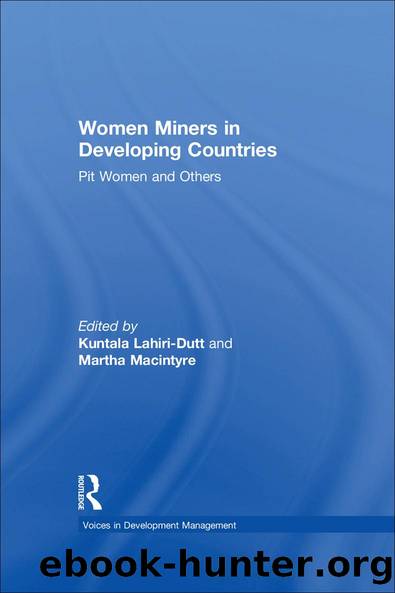Women Miners in Developing Countries by Martha Macintyre Kuntala Lahiri-Dutt

Author:Martha Macintyre, Kuntala Lahiri-Dutt [Martha Macintyre, Kuntala Lahiri-Dutt]
Language: eng
Format: epub
Tags: Nonfiction, Science & Nature, Technology, Mining, Social & Cultural Studies, Social Science, Gender Studies
ISBN: 9781351871938
Publisher: Taylor and Francis
Published: 2017-05-15T04:00:00+00:00
1 Gender as used here is not just men and women, male and female, but a social and linguistic construction, a non-stable social meaning ascribed to the male and female. Women, femininity and female experiences are understood as constituted and open rather than as robust unities. Thus, experiences are not associated with the whole, coherent person, but are constituted through the discursive invocation of a person as a âmanâ or as a âwomanâ. Here, I follow Hollway et al. (1998, p. 252) âGender-differentiated practices depend on the circulation between subjectivities and discourses which are availableâ.
2 As explained before in this book, âkaminâ is the common name of Indian women mineworkers working at manual jobs in the mines. The term is a feminine opposite of âcoolieâ, the physical labourer in almost all contexts in India. Kamins can be found also in the quarries such as stone. Writing in 1940, B. R. Seth in his book Labour in the Indian Coal Industry (p. 63) describes: âThe word kamin refers to female worker(s) employed on the surface and underground, and the word âkhalasiâ to one who cleans and handles the pump, haulage and winding engines during their operationsâ¦â.
3 Sometimes these myths involve the propagation not only of simple macho superstitions but also pervade the psyche of researchers, mining technocrats, trade unions and policy-makers. It is beyond the scope here to go into these myths although I have discussed them in the introduction. For a recent publication portraying the mines as masculine places see Kideckel, 2004.
4 Everett Hughes (1951) first invoked the term âdirty workâ to refer to tasks and occupations that are likely to be perceived as disgusting or degrading. Consequently, workers are seen to personify the dirty work.
5 Following Henriques et al. (1984, p. 105), I would define the term a regulated system of statements, locked in an intricate web of practices, leading to the production of knowledge.
6 This term has recently come to be used in ways loaded with meaning, for example, as the construction of lives through the unveiling of life histories (see Stewart and Strathern, 2000). In fact many books and papers identify mining itself as a special kind of work that attributes a special kind of identity to its workers. That is not the meaning I wish to use here but rather as âThe process by which the individual creates her/his own identityâ (see Helve, 1998).
7 Khadan is a Hindi word meaning the mine pits producing a large range of mineral products from deep and shallow, and even open cut mines and quarries.
8 See Heritage, 2001. This is just one small example of the increasing trend of rediscovering women's histories in the mines. In the International Mining History Conference in Japan in 2003, I met a passionate American woman who has been collecting the oral histories of women miners in the Appalachians. Many of these histories are easily accessed on the internet (see for example http://cass.etsu.edu/archives/afindaid/a355_06.html or http://www.coalminerstamp.com.pdfs/oth_women.pdf or www.mishmash.com/marat, all accessed on 1st July 2004).
9 Following Henriques et al.
Download
This site does not store any files on its server. We only index and link to content provided by other sites. Please contact the content providers to delete copyright contents if any and email us, we'll remove relevant links or contents immediately.
Whiskies Galore by Ian Buxton(41544)
Introduction to Aircraft Design (Cambridge Aerospace Series) by John P. Fielding(32896)
Small Unmanned Fixed-wing Aircraft Design by Andrew J. Keane Andras Sobester James P. Scanlan & András Sóbester & James P. Scanlan(32583)
Aircraft Design of WWII: A Sketchbook by Lockheed Aircraft Corporation(32140)
Craft Beer for the Homebrewer by Michael Agnew(17940)
Turbulence by E. J. Noyes(7720)
The Complete Stick Figure Physics Tutorials by Allen Sarah(7152)
The Institute by Stephen King(6809)
Kaplan MCAT General Chemistry Review by Kaplan(6606)
The Thirst by Nesbo Jo(6457)
Bad Blood by John Carreyrou(6286)
Modelling of Convective Heat and Mass Transfer in Rotating Flows by Igor V. Shevchuk(6232)
Learning SQL by Alan Beaulieu(6048)
Weapons of Math Destruction by Cathy O'Neil(5854)
Man-made Catastrophes and Risk Information Concealment by Dmitry Chernov & Didier Sornette(5674)
Permanent Record by Edward Snowden(5551)
Digital Minimalism by Cal Newport;(5398)
Life 3.0: Being Human in the Age of Artificial Intelligence by Tegmark Max(5201)
iGen by Jean M. Twenge(5172)
